|
American Robin (Turdus migratorius)
Species Code: TUMI
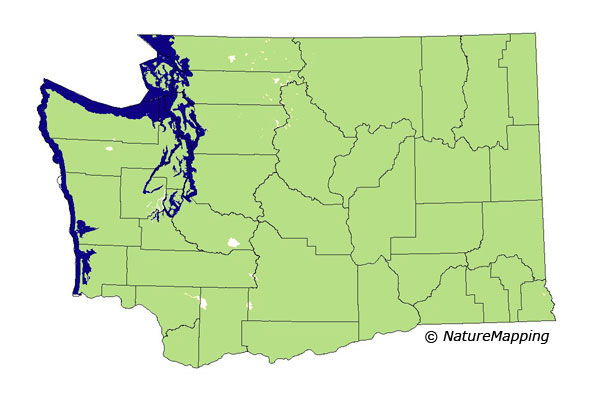 What they look like:
The American Robin is about 10 inches long (25 cm), and has a brick-red
breast, with gray wings, head and back. The short beak is yellow. It has
a white throat with black stripes; the males throat is darker than the
female. The lower belly is primarily white. It has a long gray/black
tail. Males and females look similar, but the males have a darker head
(often black) and the female has paler color. There is a broken white
eye-ring that surrounds their dark eyes.
The juvenile's under parts are tinged with cinnamon and heavily spotted
with brown (see photo).
What they look like:
The American Robin is about 10 inches long (25 cm), and has a brick-red
breast, with gray wings, head and back. The short beak is yellow. It has
a white throat with black stripes; the males throat is darker than the
female. The lower belly is primarily white. It has a long gray/black
tail. Males and females look similar, but the males have a darker head
(often black) and the female has paler color. There is a broken white
eye-ring that surrounds their dark eyes.
The juvenile's under parts are tinged with cinnamon and heavily spotted
with brown (see photo).

Where they live: In North America, American Robins breed from Alaska east to Newfoundland, Canada and south to California and east to Florida. The American Robin can be found in farmlands, suburbs and urban neighborhoods.
What they eat: The American Robin eats earthworms, insects and berries.
Behavior: The American Robin is commonly heard singing in forests and suburbs. Calls include a loud, liquid song, a variable cheerily cheer-up cheerio. Another call is a rapid tut tut tut. Robins are often seen on lawns, with their heads cocked, searching for earthworms and insects.
American Robins are Neotropical migrants, although they are found year-round in mild climates.
 Nesting:
American Robins pair-bond during the breeding season. Both parents build
the nest that is made of twigs, mud and lined with dry grass.
Sometimes the nest will have string or ribbon that the robins find in
the yard (see nest photo). The cup-shaped nests are built in a bush, tree or under the
eaves of buildings. The female typically lays two to four light blue eggs. The
female incubates the eggs over a two-week period and both parents care
for the young. The eggs take around two weeks to hatch and the chicks
will fledge when they are about 14 to 16 days old. The female may have
two broods a year. The young are born with their eyes shut and first
open their eyes around five days after hatching.
Nesting:
American Robins pair-bond during the breeding season. Both parents build
the nest that is made of twigs, mud and lined with dry grass.
Sometimes the nest will have string or ribbon that the robins find in
the yard (see nest photo). The cup-shaped nests are built in a bush, tree or under the
eaves of buildings. The female typically lays two to four light blue eggs. The
female incubates the eggs over a two-week period and both parents care
for the young. The eggs take around two weeks to hatch and the chicks
will fledge when they are about 14 to 16 days old. The female may have
two broods a year. The young are born with their eyes shut and first
open their eyes around five days after hatching.
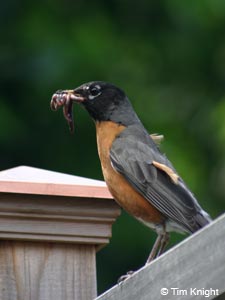 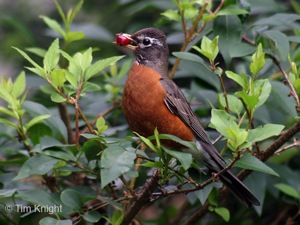 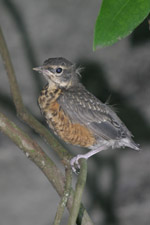
Photos of American Robin male, female and juvenile.
More information:
American Robin Blog - Nesting photos and behavior
American Robin Facts for Kids
American Robin - WDFW Living with Wildlife
Includes information on Baby Birds Out of the Nest
American Robin Nests & Eggs
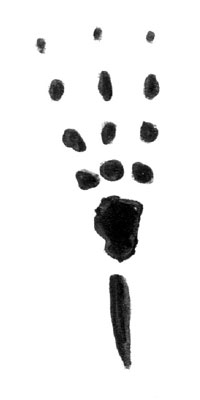
American Robin Tracks
|
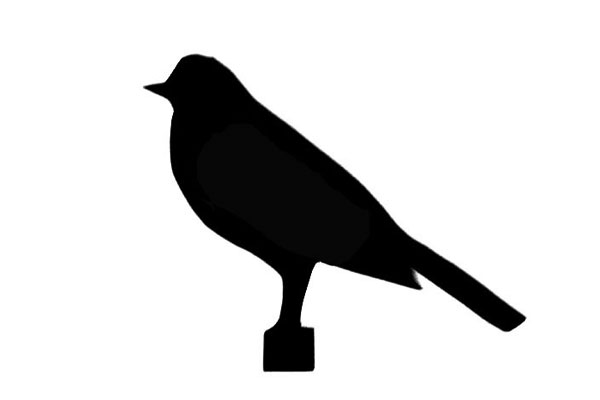
American Robin Silhouette |
Tracks by by J. Wernet, age 12
Animal silhouettes available to purchase »
Home |
About Us |
How to Participate |
Biodiversity Modules |
Projects |
Maps |
News |
Resources
| 



